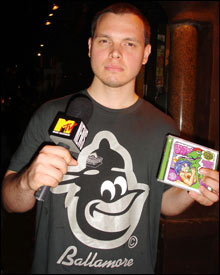
|
A quick glance at today’s commercial hip-hop and club music suggests a fairly bleak future for parties to come. Pharrell’s been too busy peddling hundred-dollar T-shirts and neon shoes to lay down a decent beat, and MCs seem to be stuck in the no-man’s land between a Bentley and a backpack. The current drought in certified hits has DJs at their wits’ end as they cue up Bel Biv Devoe for the thousandth time.
Yet just as all hope seems lost, partygoers are being introduced to a new sound that’s been simmering in Baltimore for over a decade. B-more Club, or simply B-more, began as an offshoot of the Miami bass sound of the late ’80s and early ’90s (think 2 Live Crew). It combined fast-paced breakbeats with recognizable samples (unlicensed, mostly) and a relentless bass assault. While B-more has long been popular throughout the mid-Atlantic states, it proved to be too fast, too raunchy, and too close to house for hip-hop, which over the last decade has been more concerned with popping Cris' and slowing to a thuggish crawl than with getting down.
More recently, as genre lines have become less stringent and DJs have become more open to regional dialects, B-more has gained wider notoriety on the strength of its uptempo ability to rock a party. But it’s also gotten a push forward by a new crop of producers and MCs. One of the main figures in this renaissance is Baltimore native and all-around busy dude Aaron LaCrate.
As you might imagine, growing up in metro Baltimore during the ’80s was not exactly yacht clubs and polo tournaments. Still, LaCrate began DJing before he turned 10 and plunged himself into hip-hop and graffiti culture. On his way up, he worked for Roc-A-Fella and Wild Pitch while starting a clothing line, Milkcrate Athletics, that became a huge hit in its own right. All the while his DJing helped expand B-more’s sphere of influence. Last year, his B-more Gutter Music mixtape with Hollertronix DJ Low Budget became a huge underground hit.
Now B-more has caught the ear of the underground and trendspotting mainstreamers – Gwen Stefani released a B-more-influenced remix of “Hollaback Girl,” and LaCrate’s remix for hipster it-girl Lily Allen appeared just as her single “Smile” hit No. 1 in England. Meanwhile, LaCrate and his production partner Debonair Samir are crafting a new brand of B-more that they refer to alternately as Gutter Music or Club Crack. Their new sound shows love to the roots of the B-more while deftly adding some elements (live MCs) and subtracting others (unlicensed samples) to push the sound to places it has never been. Later this year, in addition to his usual thatch of remixes, LaCrate will release his new Club Crack brand of B-more on the megaindie label Koch, giving the music an even wider exposure. He spoke to ThePhoenix.com from New York about DJing, cashmere sweaters, and the future of B-more club.
You started pretty young. How long have you been at this?
The whole DJ thing started when I was maybe eight or nine years old. It’s just the neighborhood that I grew up in in Baltimore. It wasn’t that there was a lot of DJs and all that, but I sort of just went from one thing to the next really quickly and was always out on the streets. I started out being a really young skateboarder, grew up skateboarding with Bucky Lasek and a guy named Brandon Novak who’s down as part of the whole Jackass thing. So just Baltimore itself, coming from the super-talented background of skaters and graffiti writers, and everyone was really young, but being young was never an excuse for not being good.
So everybody was sort of moving in the same direction.
It was a whole different group of people that were in this subculture but everyone was just really above average with it. Baltimore just never got any credit for anything, even after The Wire came out, making it sort of popular how grimy the city is. The city was a hell of a lot worse when I was a kid growing up.
When did you start to hear the music that people are now calling B-more?
Just from being a DJ in Baltimore, it was interesting because hip-hop was not the first choice in a party situation. Whereas you go to most parties, even back in New York in those days, it was all about hip-hop, reggae, or whatever. Baltimore was like its own little world. It had a huge nightclub scene in the late ’80s – they were playing hard house, Chicago house, a little Louie Vega and Kenny Dope. Baltimore just favored house music a bit longer than everywhere else. I remember going to clubs and you’d be lucky if you heard like five hip-hop records all night, and it would be only the biggest records of the moment. Everything else was basically growing out of the house era.